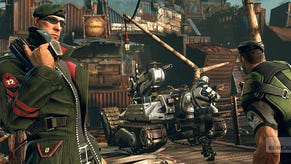Brink
In close proximity.
Having cleared a good number of the aforementioned mothers, it's time to blow the barricade under covering fire from my AI team-mates. When the explosive is strapped on you're given 15 seconds until detonation, but rather than just legging it you first need to defend, because enemies can come over and rip it off. You need to worry about it remaining in place but also to keep an eye on the count, lest you get blown up when it finally does go off.
Blowing the barricade opens up a command post, and these can be used to change classes at any time. In this case I'm convinced by the tutorial to go for Engineer because the next objective requires it. Using the objective wheel I assume a new target, and on the way I play around with the Engineer's new abilities - for example, I can buff my own damage, coating my shotgun in shimmery varnish that amplifies death.
At this point Brink feels like an interesting counterpoint to Valve's imperious Team Fortress 2, another class-based multiplayer shooter where the developers sought to create a simple visual language that people could quickly interpret and adapt to - most notably in weapons like the medical gun, which fires a stream of healing red crosses into an ally. Brink has similar principles, but Splash Damage's expression of them is less extreme and caricatured.
While the objective wheel is a good example of this, SMART is the ultimate example. It's a shoulder button that you can hold to automate climbing, vaulting, sliding and other moves that you would otherwise have to remember a button combination to perform. The rationale is that moving around should be easy and cool because you're busy trying to shoot people or get to objectives. If you're pursuing, your target is more interesting if they're agile and elusive.
In some ways it's the keystone to the whole crossover between single-player and multiplayer. It's quite difficult to suspend your disbelief about being in a futuristic war against hardened, brainwashed super-soldiers or freedom fighters if the guy you're up against was just mown down because he ran into a doorframe or snagged himself on the corner of a box. With SMART that shouldn't happen, and so you'll continue to hang your disbelief somewhere on the other side of the room.
That's clever anyway, and everyone - rather than just inexperienced players - should enjoy the impact SMART has on the way they play. However, it also has depths to explore. At one point I'm running along holding SMART and I drop into a slide so I'm harder to target, but in this position I can also fire in another direction without losing my original momentum - and all I need to worry about is pointing and shooting.
The third phase of the challenge level offensive involves switching to an Operative and assaulting another objective I can only reach from above. As I'm climbing onto a gantry using SMART, my Bethesda rep notes that if I had combined SMART with the jump button at the last moment I would have vaulted the railing with my gun ready instead. These advanced applications are obviously designed to open up new behavioural possibilities within the game world - an exciting prospect in an era where most FPS games are still arguing over whether to let you jump over hedges.
















